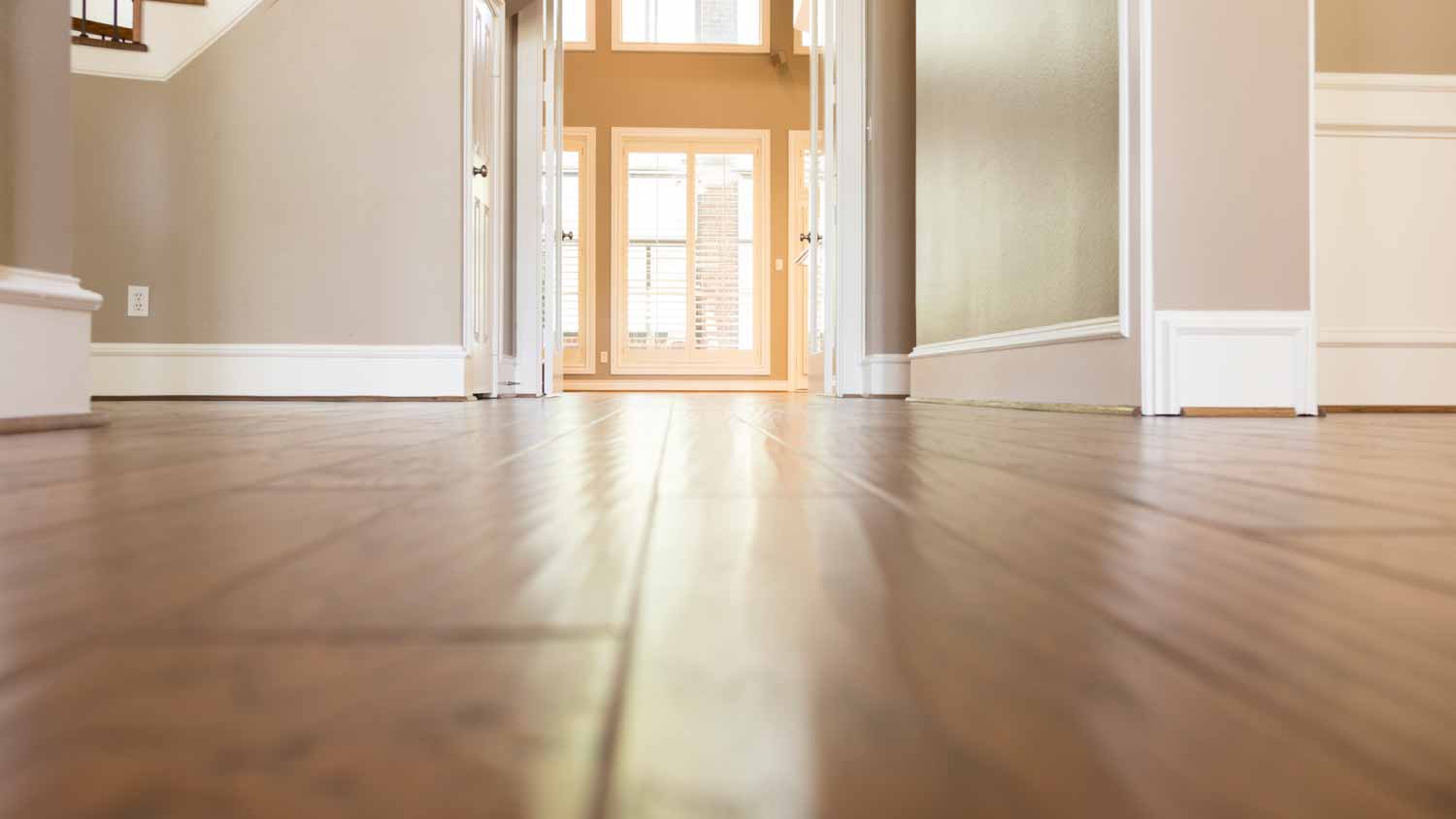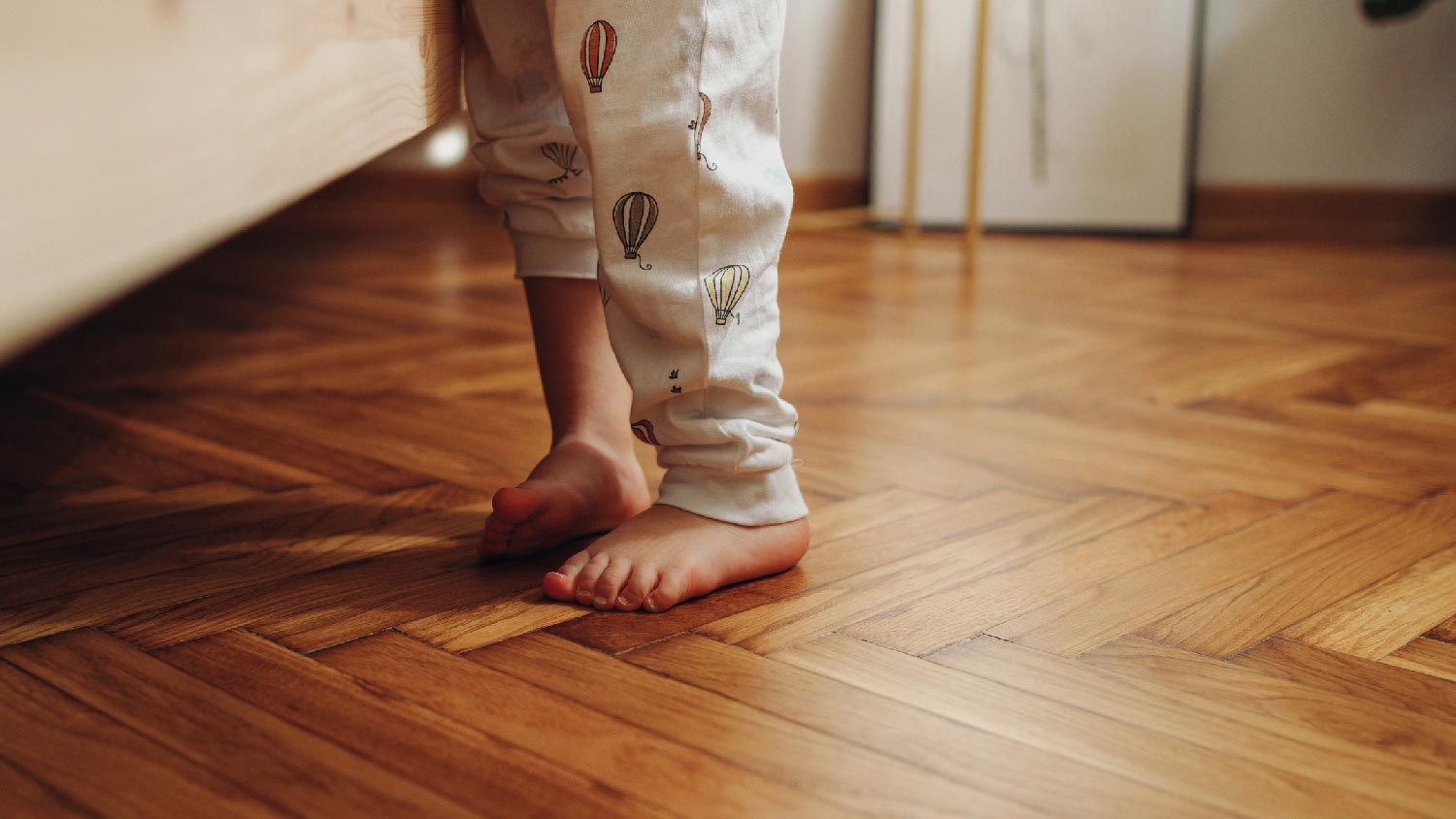How to Strip and Wax Floors: A Step-by-Step Guide
Wax on, wax off! Take your floor from dingy and dull to clean and gorgeous.


Think of everything we put our floors through—dirt and water tracked in on our shoes, pets and toddlers making messes, the inevitable spills and splashes of food and drinks. It is no wonder that floors need to be cleaned, swept, and maintained regularly.
If you have hardwood floors, learning how to strip and wax floors will help to keep them in great shape. Use our step-by-step guide to stripping and waxing floors to maintain long-lasting shine and protection.
How to Prep to Strip and Wax Floors

Preparing to strip and wax floors requires gathering a few supplies and doing a thorough cleaning. Supplies include:
Wax stripper
Wet-dry vacuum
Clean cloths
Steel wool
Mop and bucket
Dry mop
Face masks
Putty knife
Rubber gloves
Electric floor buffer (optional rental)
After gathering your supplies and tools, remove all furniture and decor from the room and clean the floor thoroughly.
How to Strip and Wax a Floor
Stripping and waxing a floor can be a time-consuming process, but it is worth it to protect wood floors and keep them looking great for years to come.
Stripping Your Floors
To strip the floors, start by reading the manufacturer’s instructions on the floor stripper container. Put on a face mask and apply the wax stripper in a three-foot-square area. Start in the back corner of the room to make sure you are not boxed in. After applying the wax stripper, use the wet-dry vacuum to remove the stripper and floor wax. If there are difficult areas with stubborn wax, you can use steel wool to scrub the remaining wax from the floor.
After removing, use the wet mop to clean the floor and remove all residual stripper and wax. Finally, dry mop the area to remove any lingering dust and let everything dry thoroughly. To accelerate the drying time, open windows and use a fan.
Apply Your Floor Wax
When the floor is dry, work in three-foot-square sections and apply the floor wax. If you choose a solid wax, use a putty knife and microfiber cloth, smoothing it as you go. If you choose a liquid wax, apply about a teaspoon to the section you are working on and spread it with a floor mop around the area.
Liquid wax is typically easier to apply than solid wax, but the finish may not last as long. Solid wax is more difficult to apply and should be done by hand rather than using a mop, but the finish tends to last longer. Regardless of what type of wax you choose, allow it to dry before determining if you need to apply additional coats.
Wearing a face mask can protect you from hazardous smells, and knee pads will make it more comfortable to work on the floor. Note: Always read the manufacturer’s instructions before starting.
Buff the Floors

Once you have allowed time for the wax to dry completely (check the manufacturer’s instructions for recommended drying time), it is time to learn how to buff wood floors. Using a soft towel or mop, buff the floor in a circular motion. If you want to save some time and energy, you can rent an electric floor buffer. Wait at least eight hours before walking on the floors or replacing the furniture.
When Should You Strip and Wax Your Flooring?
Wood flooring is incredibly durable and a popular choice for both its appearance and ability to hold up to daily wear and tear. That said, wood flooring will show wear and tear eventually in the form of dull spots, scratches, and scuffs. If your floor was finished with wax (you can tell by gently scraping the surface with a coin or fingernail to see if a waxy substance builds up), then stripping off the old wax and applying new wax will give it a beautiful refresh.
In some cases, you can strip and wax your flooring every six months to two years, which allows you to restore hardwood floors without sanding them, but the actual time between waxing will depend on the amount of activity in the home. Empty nesters likely will not need to refinish their hardwood floors as often as families with small children and pets.
Tips for Maintaining Stripped and Waxed Floors
Follow these tips to keep your freshly waxed floors looking great:
Enforce a “no-shoe” policy in your home.
If areas of the floor start to fade or look dingy, use a dry cloth to complete a spot-buff.
Re-wax your floors every six months to two years, depending on the floor wax manufacturer’s suggestions.
How Much Does It Cost to Strip and Wax Wood Floors?
Most contractors charge by the square foot to strip and wax wood floors. You can expect to pay anywhere from $0.50 to $1.75 per square foot for professional services. This breaks down to $63 to $188 to hire a flooring professional to wax and strip 125 square feet of wood flooring. Be aware that some contractors will charge a minimum service call fee, even for small jobs.
DIY vs. Hiring a Pro
With the right tools and equipment, reinvigorating your floors is a doable DIY project. If the floor stripping and waxing process seems too complicated or time-consuming, contact a local hardwood floor refinishing company to complete the project for you. Before hiring a pro, get project price quotes from multiple local companies to find the best deal possible.
Frequently Asked Questions
The answer to this question depends on how large the room is and how much experience you have stripping and waxing floors. It will take at least 24 hours to strip the floors, then you must allow time for drying, waxing, waiting for them to cure, and, finally, buffing them. Since you likely will not be working for the full 24 hours, it is safe to say that this is a two- or three-day job.
Yes, vinegar and water can strip wax. For a DIY wax stripper, mix about a quarter cup of vinegar with one gallon of warm water. You can also mix one cup of cream of tartar, one cup of white vinegar, and one gallon of water. Before using it on a large area of the floor, you should test it in an inconspicuous place to make sure it works like you want it to.
You should strip and wax hardwood floors every six months to two years. The actual length of time between stripping and waxing depends on the wear and tear that the floors see. Stripping and waxing floors can help repair hardwood floor damage and give the room a fresh look.





- How to Get Wax Out of Carpet with Common Household Items
- 15 Brilliant Uses for Wax Paper Throughout the Home
- How to Remove Candle Wax From 7 Surfaces and Materials
- How to Make DIY Citronella Candles in No Time
- How to Restore Hardwood Floors Without Sanding: A Complete DIY Guide
- 7 Types of Hardwood Flooring Finish to Protect Your Investment
- How to Paint Hardwood Floors for the Best Results
- How to Care for Hardwood Floors So They Always Look Gorgeous
- 9 Great Tips for Refinishing Your Hardwood Floors
- How to Insulate a Floor for Minimum Drafts and Maximum Comfort










